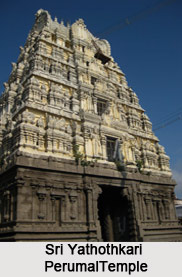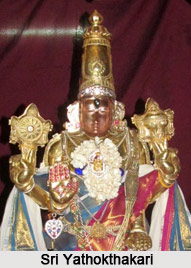 Sri Yathoktakari Perumal Temple is one of the significant Vishnu temples of Kanchipuram. This ancient and the much venerated temple is stationed away in a by lane called Yathoktakari Sannidhi Street of T.K.Nambi road in Chinna Kanchi or Vishnu Kanchi. TheYathoktakari Perumal Temple is located very near to the Ashtabhujasvami temple, about one and a half kilometers west of the Varadarajasvami temple. The place where the temple is stationed is also known as Tiruvehkha.
Sri Yathoktakari Perumal Temple is one of the significant Vishnu temples of Kanchipuram. This ancient and the much venerated temple is stationed away in a by lane called Yathoktakari Sannidhi Street of T.K.Nambi road in Chinna Kanchi or Vishnu Kanchi. TheYathoktakari Perumal Temple is located very near to the Ashtabhujasvami temple, about one and a half kilometers west of the Varadarajasvami temple. The place where the temple is stationed is also known as Tiruvehkha.
The shrine of Yathoktakari Perumal is one of the oldest in Kanchi and in all of Tamil Nadu as it has been mentioned in the Perumbanattrupadai, a treatise in the Tamil language composed in the Sangam age belonging to approximately 2nd century A.D. The main deity which is placed in the temple sanctum is known as Lord Yathoktakari. According to the common belief a devotee named Yathoktakari accepted the request of Tirumalisai Alwar to follow him out of Kanchipuram, and again return and lie down. The very name of the temple signifies a special meaning.Yathokta means "as requested" and Kari means "a person who did it." Hence the temple is named so following the name of the devotee of Tirumalisai Alwar. The deity which is housed in this temple is eulogized by the early Azhvars or the Mudal Azhvars. The significant Azhvars like Poygai Azhvar and Pey Azhvar and Tirumazhisai Azhvar and Tirumangai Azhvar, have sung the glory of the deity in their hymns. The distinguished Srivaishnava preceptor, Vedanta Desika, has composed a beautiful Sanskrit poem consisting often verses called Vegasetu Stotra in praise of this deity.
Tiruvehkha is also very important to Vaishnavas as it is the birthplace of Poygai Azhvar, one of the famous early Azhvars. The word `Poygai` in Tamil means tank. Hence the tank in this temple (Poygai Pushkarini) is revered by the devotees as the birth-place avatara-Sthala of this Azhvar.
The temple of Yathokta is considered as one of the ancient temples of Kanchipuram, representing antiquity and legendary magnificence at the same time. The traditional importance of the temple is enhanced by the legendary stories associated with the shrine. According to the temple-legend, the common belief runs that Goddess Saraswati intended to spoil the yajna or sacrifice of Brahma at Satyavrata Kshetra which is situated near this temple. She assumed the shape of the swift-flowing river Vegavati to wash away the sacrifice. At this very time, Vishnu, at the request of Brahma prevented the further flowing of Saraswati in the form of the river. He lay down in the path of the river on His serpent Adisesha. Lord Vishnu then put His head on His right arm in the form of a bridge and prevented it from flowing further. The river then disappeared in the underground. As Vishnu lay blocking the course of the Vegavati River, he came to be identified as Vegasethu in Sanskrit and Vekkanai in Tamil.
 It is believed that the deity lying down in recumbent posture here originally rested with His head on His right hand. The temple-legend narrates the entire episode of how Vishnu later reclined with His head resting on His left hand in this shrine. As the legends connected with the temple state, Tirumazhisai Azhvar lived at this place for some time and with his erudite student, a poet named Kannikannan. The king of Kanchi wanted Kannikannan to compose a poem in his honour. But Kannikannan refused the request of the king. He told the king that having already sung in praise of the Lord, he would not sing in praise of mere mortals. The king became furious with the rejection of Kannikannan. Consequently the furious king banished the bard from the kingdom. As a result of this incident Tirumazhisai Azhvar also decided to go with his student and requested the God to accompany them. The Lord accompanied his disciple as requested and when the trio left Kanchi, the town, bereft of the Lord was covered in darkness. The king understood the mistake he made by passing the verdict to banish the poet Kannikannan. The repentant king, now realizing his folly, requested them to return and the Lord went back to his original place and lay down in his seat. But this time with His head on His left arm to show that He had left the place and returned to it. Thus, Vishnu here is called Yathoktakari (in Sanskrit) and Sonnavannam Seyda Perumal (in Tamil), both signifying the `one who did as was told.` The place where they spent the short time away from the temple is called `Oru Trrukkai` or the place where they stayed for one day. It is now called Orikkai, situated very near Kanchipuram. This place also is highly venerated due to its legendary importance.
It is believed that the deity lying down in recumbent posture here originally rested with His head on His right hand. The temple-legend narrates the entire episode of how Vishnu later reclined with His head resting on His left hand in this shrine. As the legends connected with the temple state, Tirumazhisai Azhvar lived at this place for some time and with his erudite student, a poet named Kannikannan. The king of Kanchi wanted Kannikannan to compose a poem in his honour. But Kannikannan refused the request of the king. He told the king that having already sung in praise of the Lord, he would not sing in praise of mere mortals. The king became furious with the rejection of Kannikannan. Consequently the furious king banished the bard from the kingdom. As a result of this incident Tirumazhisai Azhvar also decided to go with his student and requested the God to accompany them. The Lord accompanied his disciple as requested and when the trio left Kanchi, the town, bereft of the Lord was covered in darkness. The king understood the mistake he made by passing the verdict to banish the poet Kannikannan. The repentant king, now realizing his folly, requested them to return and the Lord went back to his original place and lay down in his seat. But this time with His head on His left arm to show that He had left the place and returned to it. Thus, Vishnu here is called Yathoktakari (in Sanskrit) and Sonnavannam Seyda Perumal (in Tamil), both signifying the `one who did as was told.` The place where they spent the short time away from the temple is called `Oru Trrukkai` or the place where they stayed for one day. It is now called Orikkai, situated very near Kanchipuram. This place also is highly venerated due to its legendary importance.
However the legend associated with the temple provide it much popularity among the Vishnu Temples of South India.
Architecture of Sri Yathoktakari Perumal Temple, Kanchipuram
The architecture and the sculptural design of the Sri Yathoktakari Perumal Temple, lend it a special significance. The wonderful carvings on the wall of the temple is an added beauty to the antiquity of the legendary temple of Kanchipuram. The main sanctum sanctorum is known as garbha-griha, which is rectangular in shape
Inscriptions of Sri Yathoktakari Perumal Temple, Kanchipuram
The inscriptions engraved on the temple wall and the pillars surrounding the temples articulate the antiquity and stately magnificence of the temple. The inscriptions on the wall not only enhances the traditional significance, but also helps to determine the actual chronology of the temple.
Festival of the Sri Yathoktakari Perumal Temple, Kanchipuram
The festivals performed in the Sri Yathoktakari Perumal Temple, provide it with a majestic grandeur. The festivals of the temple represents the essence of the tradition of the temple. The famous among the festivals performed is the Brahmotsavam festival.





















